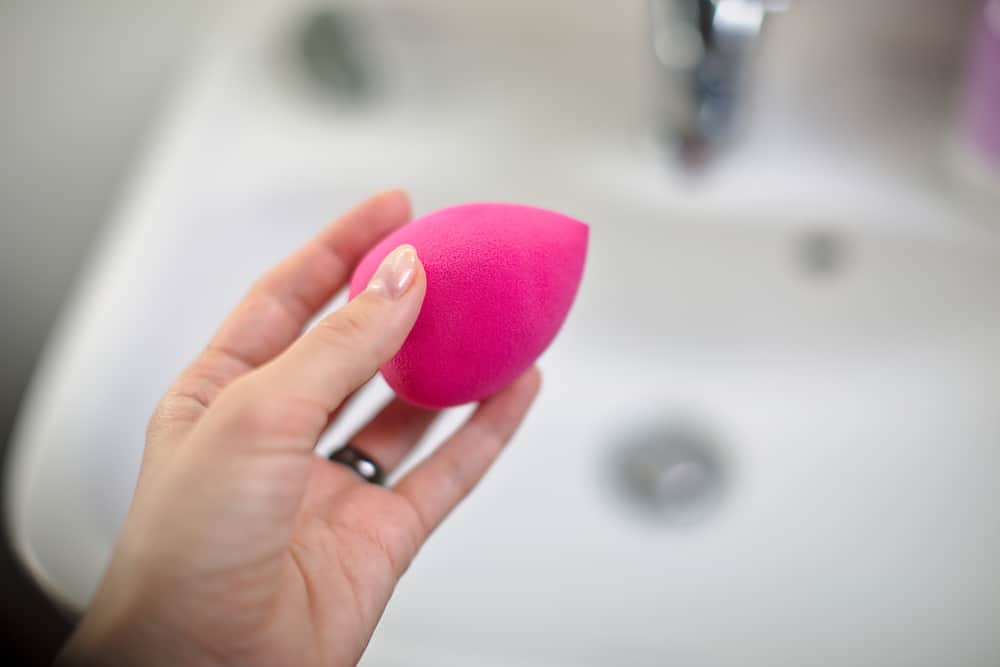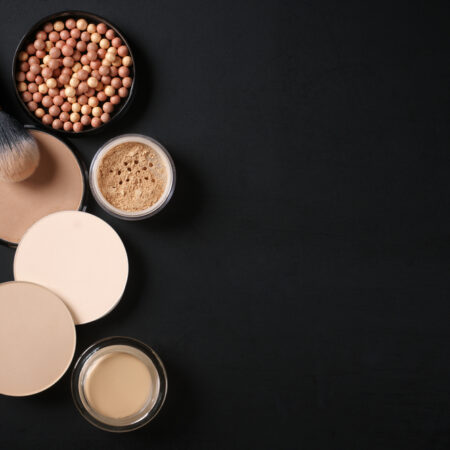When you apply makeup, you’re putting a foreign substance on a thin barrier protecting the rest of your body from the outside world. Most people don’t realize it, but the particles from makeup can actually seep into the rest of our body — that’s very bad news if the products in question contain harmful chemicals or bad bacteria.
If you consider yourself a sanitary freak when it comes to your makeup, you might replace your products every six months and never share them with others. But do you clean your makeup itself and everything it comes into contact with? For the vast majority of people, the answer to that question is a big, fat “no.”
Fall into this camp? It’s about time you changed your ways — here’s a guide to how you can do it.
Sanitizing Your Makeup: A Product-By-Product Guide
Well, there’s no point in beating about the bush (or should we say the brush) — it’s time to explain exactly how to sanitize your makeup. Anyone who’s found their way to this article is no doubt aware there’s an endless list of different makeup products and applicators, so let’s run through them one by one. First, however, you need to have the following disinfectant on hand.
Disinfecting With Alcohol
Most makeup products and tools require 70% isopropyl alcohol (with the remaining 30% being a water-based solution) for the sanitization process. This antiseptic and rubbing alcohol does a great job at exterminating fungi, viruses, and bacteria.
You might be tempted to buy a higher concentration if you see it available, but counterintuitively, rubbing alcohol is actually less potent at disinfecting above a concentration of around 80%.
So, make life easy for yourself and stick to the 70% stuff. You should be able to find some in your local supermarket. It’s also a good idea to transfer the alcohol into a spray bottle, since this is the easiest way to apply it to your products and clean them.
Oh, and grab some sanitizing wipes for good measure — it will make your life easier for certain products.
Brushes
We all know that we should clean our makeup brushes regularly, but how many of us really do it? And no, a quick rinse under the faucet with cold water doesn’t count.
Give your tools the attention they deserve by adding a regular, thorough wash into your beauty routine. Instead of using water and soap, buy a makeup brush cleanser designed for this specific purpose, or even baby shampoo (it’s far gentler than adult shampoo). Or a DIY solution if you’re feeling fancy.
Clean your brushes to remove makeup residue, then follow up with a spray of your rubbing alcohol. Finally, leave them to dry overnight.
What about frequency? A weekly clean works best in most cases, especially for brushes with either synthetic or animal hairs (which is almost all brushes). More than this is getting a little excessive unless you’re sharing your stuff with other people — but go for less often and you risk subjecting your skin breakouts.
Sponges

Brushes and sponges serve the same purpose, but their sanitization processes work a little differently.
Unfortunately, it’s impossible to completely sanitize sponges since there’s no way of reaching their very center — but you can still give them a (relatively) thorough cleanse. Prepare a bowl of lukewarm water, then give the sponge a gentle clean with dish soap. After you’ve done this, you’re still not finished!
Next, immerse the sponge in a tub of water and put it in the microwave for around two minutes, which should kill off any remaining bacteria.
If you want to be as hygienic as possible, we recommend turning to disposable sponges instead to avoid the build-up of bacteria in the middle of the item. But hey, you do you.
Eyelash Curlers
Known to some as torture instruments and others as miracle workers, eyelash curlers are a controversial beauty tool — but the need to sanitize them certainly isn’t. We have to use eyelash curlers just above the delicate eye region, so contracting an infection wouldn’t exactly be unheard of.
To prevent this from happening, give your curlers the alcohol treatment! Start off by removing any residue from makeup, then move on to sanitization by adding the alcohol.
Leave the curlers for at least 24 hours to dry — trust us, you don’t want any traces of alcohol getting into your eyes the next day.
Lipsticks
While knowledge about cleaning brushes and sponges is fairly commonplace, sanitizing lipstick is a little more niche. But fear not, it is possible!
Grab your rubbing alcohol and spray it lightly to the lipstick (with the cap off, of course). Then, wipe it down, unless you want a lovely taste of antiseptic alcohol on your lips next time you try to apply it.
Mascaras
We had to include mascara on this list since it’s such a staple beauty item, but we’re afraid it’s bad news. Mascara doesn’t withstand sanitization very well, and attempting it could cause more problems than it solves.
Instead, you’re best to chuck out your product when you have any concerns and opt for a newer, more sanitary replacement. If you’ve found that your mascara becomes flaky after application — or you’ve noticed redness or irritation around the eye after use — it might be time to do exactly that.
Another tip is to use a new disposable mascara wand every time you apply the product to your lashes rather than turning to the in-built wand. Yes, it might sound excessive, but it’s what all professional makeup artists do to prevent transferring bacteria from client to client. Most makeup lovers don’t need to go to such length, but if you’re prone to eye infections, it’s worthwhile.
Lip Glosses
Lipstick and lip gloss may both be used on the same part of the face, but the lip gloss sanitization process actually has more in common with that of mascara. After all, both products come with their own in-built applicators. Can you guess what the advice is for this one?
Again, we recommend using a separate disposable applicator if you share products or are prone to infection. Alternatively, you could get around the problem by applying the lip gloss straight to your (sanitized) hand instead of your lips, as it’s easier to ensure hygiene on other surfaces. Then, you can use your lips or another brush to apply the gloss to your lips.
Pencils
No, we’re not talking about the pencils used for drawing and writing (although you could probably sanitize those too if you really wanted to). But lip liners and eye pencils certainly call for regular sanitization since we apply them to such delicate areas of the face.
Fortunately, there’s a quick hack here: just sharpen them! This will remove the outside layer and any possible bacteria lurking, in addition to keeping your tools sharp. If you want to go the extra mile, you could also spray a small amount of disinfectant on after sharpening.
Liquids and Creams
There’s not much you can do to sanitize your actual liquids and creams, but you can certainly make sure their containers are clean.
Start by spraying the top and sides of the tub with rubbing alcohol, then wipe it down. This should dry pretty much immediately.
Also, it should go without saying, but never dip your fingers into your creams or liquids — this is a recipe for a massive germ party. Instead, buy a proper plastic applicator.
Felt-Tip Eyeliners
In the past, eyeliners were either liquid or pencils; two categories we’ve covered already. But this is the twenty-first century, so our list wouldn’t be complete without also including felt-tip eyeliners.
As you might imagine, they’re pretty difficult to sanitize, but not impossible. Get some sanitizing wipes and use one to squeeze the tip of the pen, which gives it an initial clean. Then, spray on some of the rubbing alcohol for good measure.
Make sure you give the tip a few minutes to dry before you close the lid, which allows the mist to fully evaporate.
Powders
Many people assume that it’s impossible to sanitize powders like blushes, eyeshadows, and face powders, but that’s not true. You can actually apply the alcohol directly to the product.
Lightly spray the top of the powder (from a distance of around five inches away), then leave it to air dry for a while. Don’t worry — it won’t ruin the products as long as you don’t go overboard.
And clean the rest of the bottle or packaging thoroughly. No matter how well you wash your hands before applying makeup, it doesn’t count for much if the packaging itself is filthy.
Makeup Bag
Don’t forget your bag itself! You might not be planning on smearing the material all over your face, but that’s effectively what you’ll be doing if all the products you are applying have been lying around in a dirty bag.
Cleaning it is easy enough — just put it in the washing machine, then spray it with your alcohol solution and leave it to dry.
If your bag isn’t suitable for the washing machine, it might be time to consider buying a new one! However, you could also opt for a wipe down with sanitizing wipes and a spray of alcohol.
How Often Should You Sanitize Your Makeup?

We’ve already covered the question of frequency for some items, but what about everything else? As with many things, the answer to this question is “it depends.”
A general rule of thumb is that someone who uses their makeup most days should sanitize easy-to-clean products every two to four weeks. You might be able to get away with sanitizing everything less often if you only use makeup occasionally, but it doesn’t hurt to be careful.
Also, if you’ve let someone else borrow your makeup (which you really shouldn’t do, by the way), it goes without saying that you should sanitize it immediately. Why would you want to transfer the bacteria from someone else’s skin straight to your own?
Other Ways to Keep Your Makeup Clean
Sanitizing your makeup regularly is essential, but it’s not the only hygiene rule you need to follow.
One aspect that many people overlook is their own hygiene. Do you always wash your hands before you touch your makeup? If not, you’re on a fast track to infecting it with all the germs that linger on your skin each day.
As we’ve touched on already, sharing your makeup with anyone else is always a terrible idea — no matter how much they “need” it after they forgot their own stuff or how much of an “emergency” they’ve found themselves in.
Also, just because you’re sanitizing your makeup, it doesn’t magically mean that it will be good to use no matter what. Once a product is expired, it’s expired, and no amount of rubbing alcohol is going to change that. So, look out for suspicious smells and any products that become flaky or dry over time.
Scrubs Up
Now you know what it takes to keep your makeup clean, it’s time to take action on what you’ve learned. Hopefully, you’ve realized that sanitization isn’t that hard after all and there’s really no excuse not to act on these simple health and safety guidelines.
Remember, this isn’t just some cute side project for you to pursue if you have the free time — the health of your body is at stake. You wouldn’t think it was okay to go months on end without washing your kitchen utensils, so why do we let it slide when it comes to makeup?
In both cases, the end destination is your body — and, as they say, our body is a temple. Show it some respect!
